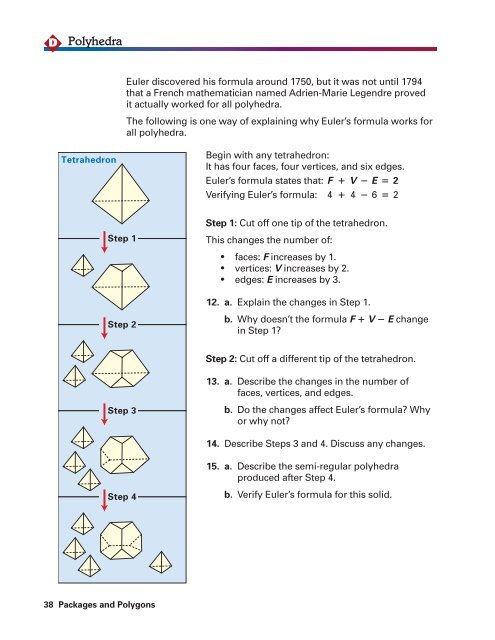Create successful ePaper yourself
Turn your PDF publications into a flip-book with our unique Google optimized e-Paper software.
D<br />
Polyhedra<br />
Euler discovered his formula around 1750, but it was not until 1794<br />
that a French mathematician named Adrien-Marie Legendre proved<br />
it actually worked for all polyhedra.<br />
The following is one way of explaining why Euler’s formula works for<br />
all polyhedra.<br />
Tetrahedron<br />
Begin with any tetrahedron:<br />
It has four faces, four vertices, <strong>and</strong> six edges.<br />
Euler’s formula states that: F V E 2<br />
Verifying Euler’s formula: 4 4 6 2<br />
Step 1: Cut off one tip of the tetrahedron.<br />
Step 1<br />
This changes the number of:<br />
• faces: F increases by 1.<br />
• vertices: V increases by 2.<br />
• edges: E increases by 3.<br />
12. a. Explain the changes in Step 1.<br />
Step 2<br />
b. Why doesn’t the formula F V E change<br />
in Step 1?<br />
Step 2: Cut off a different tip of the tetrahedron.<br />
13. a. Describe the changes in the number of<br />
faces, vertices, <strong>and</strong> edges.<br />
Step 3<br />
b. Do the changes affect Euler’s formula? Why<br />
or why not?<br />
14. Describe Steps 3 <strong>and</strong> 4. Discuss any changes.<br />
15. a. Describe the semi-regular polyhedra<br />
produced after Step 4.<br />
Step 4<br />
b. Verify Euler’s formula for this solid.<br />
38 <strong>Packages</strong> <strong>and</strong> <strong>Polygons</strong>













